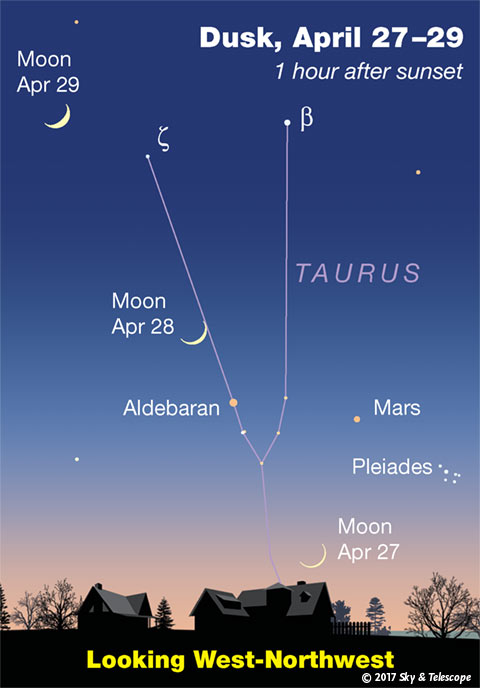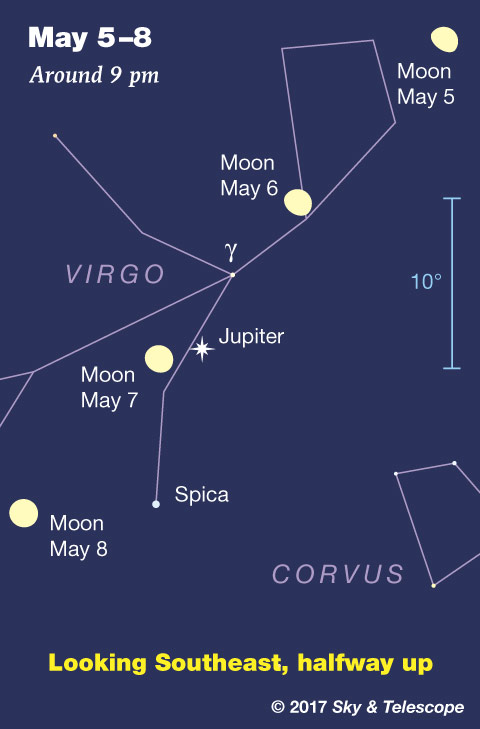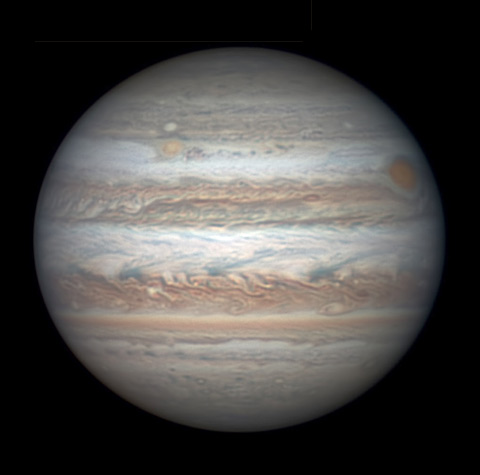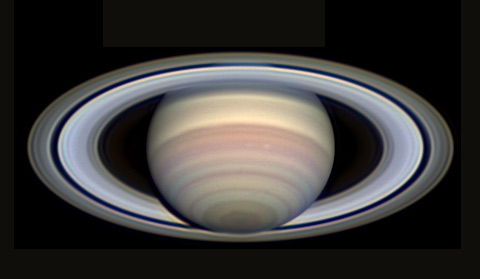
Friday, April 28
• As twilight fades in the west, spot Aldebaran and Mars to the lower right of the crescent Moon, as shown here.
Saturday, April 29
• Now the curve of the crescent Moon points far down toward Aldebaran and Mars at dusk, as shown here. And the horns of Taurus, Zeta and Beta Tauri, occupy roughly the same stances with respect to the Moon as Aldebaran and Mars did last night.
Sunday, April 30
• These spring evenings, the long, dim sea serpent Hydra snakes far across the southern sky. Find his head, a rather dim asterism about the width of your thumb at arm's length, in the southwest. (It's lower right of Regulus by about two fists at arm's length.) His tail reaches all the way to Libra rising in the southeast. Hydra's star pattern, from forehead to tail-tip, is 95° long.
• As twilight fades, look above the crescent Moon in the west for Pollux and Castor, and a similar distance left of the Moon for Procyon.
Monday, May 1
• At nightfall, the first-quarter Moon forms part of a gigantic curving arc: To the Moon's lower left is Procyon, to its upper right are Pollux and Castor, and continuing way farther right, you can include Menkalinan and then brilliant Capella. These stars alone, minus the Moon, form the Arch of Spring.
Tuesday, May 2
• It's May now. But wintry Sirius still twinkles very low in the west-southwest in twilight, far below Procyon. It sets soon after dusk. How much longer into the spring can you keep Sirius in view each evening? In other words, what will be its date of "heliacal setting" as seen by you?
Wednesday, May 3
• The waxing gibbous Moon this evening, 1.3 light-seconds away, shines near Regulus, 79 light-years away. Regulus is the bottom star of the Sickle of Leo and marks Leo's forefoot.
Thursday, May 4
• The moon now shines under the belly of Leo — with Regulus to its right, Algieba a little farther to its upper right, and Denebola a lot farther to the Moon’s upper left.

Friday, May 5
• Now the Moon is under Leo's tail star, Denebola (by about a fist at arm's length). To the Moon's lower left is bright Jupiter, with Spica about half again farther on.
Saturday, May 6
• The Moon tonight forms a gently curving arc with, to its lower left, bright Jupiter and then Spica. Look between the Moon and Jupiter for 3rd-magnitude Porrima (Gamma Virginis), a fine, close telescopic double star.
• Summer is more than six weeks away, but the Summer Triangle is beginning to make its appearance in the east, one star after another. The first up in view is Vega. It's already visible low in the northeast as twilight fades.
Next up is Deneb, lower left of Vega by two or three fists at arm's length. Deneb rises about an hour after Vega does, depending on your latitude.
The third to rise is Altair, which shows up far to their lower right around midnight.
________________________
Want to become a better astronomer? Learn your way around the constellations! They're the key to locating everything fainter and deeper to hunt with binoculars or a telescope.
This is an outdoor nature hobby. For an easy-to-use constellation guide covering the whole evening sky, use the big monthly map in the center of each issue of Sky & Telescope, the essential guide to astronomy.

Once you get a telescope, to put it to good use you'll need a detailed, large-scale sky atlas (set of charts). The basic standard is the Pocket Sky Atlas (in either the original or Jumbo Edition), which shows stars to magnitude 7.6.
Next up is the larger and deeper Sky Atlas 2000.0, plotting stars to magnitude 8.5; nearly three times as many. The next up, once you know your way around, is the even larger Uranometria 2000.0 (stars to magnitude 9.75). And read how to use sky charts with a telescope.
You'll also want a good deep-sky guidebook, such as Sue French's Deep-Sky Wonders collection (which includes its own charts), Sky Atlas 2000.0 Companion by Strong and Sinnott, or the bigger Night Sky Observer's Guide by Kepple and Sanner.
Can a computerized telescope replace charts? Not for beginners, I don't think, and not on mounts and tripods that are less than top-quality mechanically (meaning heavy and expensive). And as Terence Dickinson and Alan Dyer say in their Backyard Astronomer's Guide, "A full appreciation of the universe cannot come without developing the skills to find things in the sky and understanding how the sky works. This knowledge comes only by spending time under the stars with star maps in hand."
This Week's Planet Roundup


Mercury is hidden deep in the glow of sunrise.
Venus (magnitude –4.7) shines low in the east as dawn brightens. In a telescope it's a crescent, thickening a little every morning. This week it's at greatest brightness.
Mars (magnitude +1.6, in Taurus) is finally sinking away in the western evening twilight after a year-long apparition. Don't confuse it with slightly brighter Aldebaran, twinkling 7° left of Mars early in the week. Aldebaran is lower left of Mars by week's end.
Jupiter (magnitude –2.4, in Virgo) shines brightly in the southeast at dusk. It's highest for telescopic viewing by about 11 p.m. daylight saving time. Spica, just a trace bluer, hangs 9° below it in twilight, and lower left of it by 11 p.m. In a telescope Jupiter shrinks from 44 to 43 arcseconds across this week, as Earth pulls away ahead of it in our faster orbit.
Saturn (magnitude +0.2, in Sagittarius) rises around 11 p.m. and glows highest in the south before dawn. Redder Antares (magnitude +1.0) twinkles 18° to Saturn's right in the early-morning hours.
Uranus is hidden in the sunrise.
Neptune is still too low before dawn.
__________________________
All descriptions that relate to your horizon — including the words up, down, right, and left — are written for the world's mid-northern latitudes. Descriptions that also depend on longitude (mainly Moon positions) are for North America.
Eastern Daylight Time (EDT) is Universal Time (UT, UTC, or GMT) minus 4 hours.
__________________________
"This adventure is made possible by generations of searchers strictly adhering to a simple set of rules. Test ideas by experiments and observations. Build on those ideas that pass the test. Reject the ones that fail. Follow the evidence wherever it leads, and question everything. Accept these terms, and the cosmos is yours."
— Neil deGrasse Tyson, 2014
"Objective reality exists. Facts are often determinable. Vaccines do stop diseases. Carbon dioxide does warm the globe. Science and reason are no political conspiracy; they are how we discover reality. Civilization's survival depends on our ability, and willingness, to do so."
— Alan MacRobert, your Sky at a Glance editor
"Facts are stubborn things; and whatever may be our wishes, our inclinations, or the dictates of our passions, they cannot alter the state of facts and evidence."
— John Adams, 1770
 0
0








Comments
You must be logged in to post a comment.